They were permitted to go back to their original lands only in 1982. They had to start all over again, to clear the pastures, to teach their children herding skills. That was 29 years ago. It is a short time span in the life of a nation, but the Tuvans managed to re-establish much during that time.
In the place of Honor - Flag and heraldic crest of their Historical Homeland
To this day, they keep the customs of their ancestors regarding introductions. Meeting a guest, they always ask from which tribe and clan he is, and his age. A person's age is very important for the carriers of the traditions - it serves to determine the etiquette of behavior with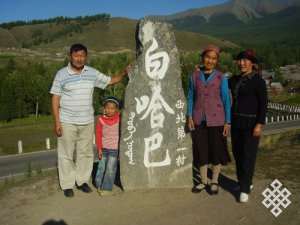 the stranger.
the stranger.
Because of the predominance of other language populations in the places where the Tuvans live, their language has many words borrowed from Kazakh, Mongolian, and Chinese languages. It shows, in particular, in the phonetic and lexical peculiarities of their daily speech. In that way, recently Kazakh language has been showing a strong influence on the lexicon and partially on the morphology of Tuvan language. Borrowings from Chinese are used predominantly in the terminology of territorial administrative units, tools of daily use (television, computer, refrigerator) it has to be noted that there are fewer words borrowed from Mongolian than from Kazakh. The phonetics of the native language of Chinese Tuvans are distinguished by the lack of pharyngealization. For example, in the words: horse - at; meat - et, and grass - ot.
In the place of honor in the homes of the Tuvans, there is a Buddhist altar, with a portrait of Banchyn-Erdine (Bogdo-Gegen of Chinese Buddhists, born in Tibet). After the forced emigration of the Dalai-Lama XIV in 1959 from china to India, it was prohibited to have his portraits. But many of my informants, as a sign of trust showed me hidden images of the Dalai-lama and told me that they pray to him anyway, considering him a living reincarnation of the Buddha. Also in the place of honor, they keep the portrait of Genghis Khan, the famous conqueror, who is especially venerated by local Tuvans and Mongols. They say that lately he replaced the portrait of Chairman Mao. Beside that, I have also seen photos of flags, heraldic crest and map of Republic Tuva, downloaded from the Internet, on the walls in places of honor of town apartments as well as in yurts.
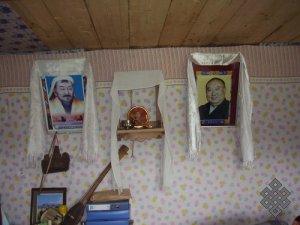 Wall clocks in the houses show Peking time, because schedule of the day and planned meetings are in Peking time. The question "What time is it?" is answered first by Peking time, then in Xinjiang time. The difference between these two is two hours, and there is four hours difference with Moscow time.
Wall clocks in the houses show Peking time, because schedule of the day and planned meetings are in Peking time. The question "What time is it?" is answered first by Peking time, then in Xinjiang time. The difference between these two is two hours, and there is four hours difference with Moscow time.
As representatives of minorities, Tuvans have certain advantages. The Chinese government regulates demographic processes very strictly. So if a Chinese woman works in a state facility, her family has the right to have one child, and if she is a housewife, it is permitted to have two children. Regarding the Kazakhs, Uighurs, Mongols and Tuvans, there is a relaxation of the rules: their families have the right to have two children if the mother works in government service. If she is a housewife, then according to the law she may have even three children. But if the woman decides to have a third child in a lawful marriage, the family has to pay a fine of 3000 Yuan.
The thing that strikes the eye immediately is the Tuvans' love for children, their respectful treatment of them. Under no circumstances will the adults punish children or beat them. Tradition of respect towards elders and unconditional obedience to them.
Until 2005, it was possible to reach the inhabited areas where Tuvans live - Ak-Khaba, Khanas, and Khom - on horseback: now there is an asphalt road. However, in winter, when avalanches are a rule, the route cannot be used.
The places in Altai aimak, where he Tuvans live, are very picturesque and beautiful. There is fresh pure mountain air and virginal nature. This corner of the Earth can be considered untouched by civilization. In China it is numbered among the most popular tourist regions. From June to September, many tourists from the whole country come here, mainly Chinese. Every day, 10 - 15 buses come here. Because of the large numbers of tourists, Chinese entrepreneurs specially come to Khom and Khanas, renting the homes of Tuvans to use as hotels.
In Khanas, the buses bring tourists and locals to the beautiful Khanas lake for free. Many Tuvans are in the tourist business. They perform in national costumes for tourists: they sing, dance, sell traditional beverages and dishes: khoitpak, tarak, aarzhy, or kurut.
In villages where Tuvans live, it is prohibited to erect felt yurts in the yards of the houses; the government believes that the yurts are disruptive of the external appearance of the village.
Everybody knows "Men - Tyva men"
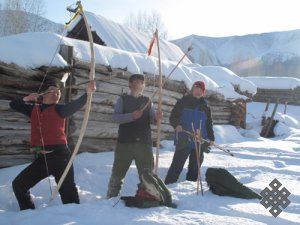 Tuvans of China are very interested in the life, existence, language situations, religion, traditions and culture of their relatives in Russia. Many want to come to visit and see Republic Tuva. How do Tuvans live in their native country, do they have their own writing, what do letters of Tuvan alphabet look like, what are their schools like, do all of them know their own language, are there poor people? Everywhere they asked me these questions. They also asked whether Russian Tuvans could admit them into their system, and if they consider Tuvans of China their relatives. There are also many people who would like to send their kids to school in Tuva.
Tuvans of China are very interested in the life, existence, language situations, religion, traditions and culture of their relatives in Russia. Many want to come to visit and see Republic Tuva. How do Tuvans live in their native country, do they have their own writing, what do letters of Tuvan alphabet look like, what are their schools like, do all of them know their own language, are there poor people? Everywhere they asked me these questions. They also asked whether Russian Tuvans could admit them into their system, and if they consider Tuvans of China their relatives. There are also many people who would like to send their kids to school in Tuva.
Young Tuvans, who study and live in cities, have access to Internet and visit websites of Russian Tuvans, download Tuvan photos and songs. They listen to and know the repertoire of famous Tuvan ethno-groups "Yat-kha", "Huun-Huur-Tu", "Tyva Kyzy" and "Chirgilchin".
It is not an exaggeration to say that every one of Chinese Tuvans knows the song "Men - Tyva men" (I am a Tuvan). There are improvised versions of the song in circulation - depending on where the singers live. For example, instead of "I am a daughter of the place of silver rivers" they may use: "I am a daughter of Ak-Khaba, or Khanas". In the past few years, a young Tuvan Khunsaa Solongo translated the song from Tuvan into Chinese on the request of one Chinese firm. It can be heard on the Internet.
Chinese Tuvans call our republic Ulug Tyva (Great Tuva) or Tyvastan ( as analogy to Kazakhstan). They call Tuvans Kyzyl Tuvans, Khemchik Tuvans, or Russian Tuvans. And Mongolian Tuvans they call Kalga-Tuvans. According to historical evidence, Tuvans of Mongolia lived in Chinese Altai until the '30's of 20th century, and later, because of a war between Kazakhs and Dunkans, they had to run to Mongolian territory.
There is a rich tradition of Tuvan oral art transmitted from generation to generation, which still plays a large role in their life. Borrowing of folklore traditions and existence of many genres can be observed. There is no significant event in the life of a person, family or nation, which could pass without appropriate rituals with national songs, blessings, or traditional sports competitions. Songs in praise of their native country, parents, in honor of a bowl of araka can be heard, as well as mythological stories about the creation of the earth, people, proverbs and sayings, riddles. However, according to the old people, much has been lost with the death of epic performers, because some genres of folklore, for example epics, were never written down.
Composed songs in Tuvan and Mongolian languages are widespread together with folk songs. The main theme of these songs is love for the native land, praise of the beauty of its nature. Songs of Solongo Shingil, "Aldyn-chechek, khek davan", and of a young teacher Kendzhe Buyuk "Saktydym" belong to the most popular and beloved. They are performed with great pleasure during various celebrations.
Playing traditional string instruments is widespread among the Tuvans - shoor, igil. There are many performers among the young generation.
Traditional versions of rituals are observed during doi-celebrations for the birth of a child, weddings, and funeral-memorial rituals. A new feature of Tuvan wedding ceremonies is the paying of kalym to the bride's parents before the wedding. The amount of the kalym is decided beforehand. The appearance of this custom is due to the fact that Tuvans have been living side by side with Kazakhs - Moslems.
Shagaa Unites the People
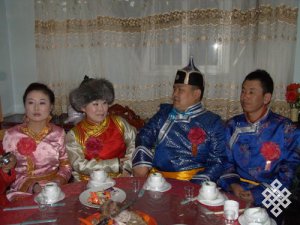 Chinese Tuvans have two big national holidays. In winter, it is Shagaa (meeting the Lunar New Year) and in summer - Ovaa dagyyry (consecration of ovaa). These holidays belong to the most beloved, people prepare for them throughout the calendar year. The main thing is not just to perform the concrete ceremonies, the heart of these holidays is that in a way they serve as a consolidation factor, which unites the Tuvan ethnos into a single whole, and increases the power of the spirit of the nation. Tuvans kill a sheep for these holidays in the traditional manner - ozeer. On other occasions they cut its throat just like the Kazakhs.
Chinese Tuvans have two big national holidays. In winter, it is Shagaa (meeting the Lunar New Year) and in summer - Ovaa dagyyry (consecration of ovaa). These holidays belong to the most beloved, people prepare for them throughout the calendar year. The main thing is not just to perform the concrete ceremonies, the heart of these holidays is that in a way they serve as a consolidation factor, which unites the Tuvan ethnos into a single whole, and increases the power of the spirit of the nation. Tuvans kill a sheep for these holidays in the traditional manner - ozeer. On other occasions they cut its throat just like the Kazakhs.
My second trip to Chinese Tuvans took place this winter, in January-February 2011, during the Shagaa celebrations - meeting the Lunar New Year. During this one month trip, I managed to document and describe Shagaa rituals, Tuvan traditional sport competitions, and many rituals of family - domestic character. I visited seven different inhabited areas and nearby winter camps where Tuvans live.
I will tell you a little bit about Shagaa. The entire population prepares thoroughly for Shagaa: cleaning in the houses, they wash all the kettles, do laundry. It is believed that everything bad, or negative, of the past year will be washed away with the dirt. Beside all this work, the housewives also prepare food beforehand for all possible guests, calculated for fifteen days, because that is how long the New Year holiday lasts.
The eve of Shagaa is called "chalsar" in Tuvan, "kuchun" in Mongolian. In 2011 it fell on 2 February. On this day, Tuvan families set up the holiday table in the afternoon, and invite old relatives for the feast. They place a burning candle chula next to the burgan. When the stars come out on the night sky, members of 4-5 neighboring families get together, and, starting with the house of the most honored person, they visit each house in turn. They sit at the holiday table in each house, feast, and carry out a special ritual: the son-in-law of the family or another young man break the hip bone of a cow or sheep. After the bone is broken with one strike, the men come out on the street with calls of "kurai-kurai", inviting happiness and prosperity, and simply shouting aloud, as they say. According to Chinese mythology, evil spirits will be frightened by it. It is believed that there are no bad people during Shagaa. Any person who comes visiting, even a total stranger, will be welcomed and feasted.
Sport competitions take place during Shagaa. Bow shooting is done only during Shagaa. Horse races and wrestling are held on New Year and on the summer holidays.
This year Shagaa was met on 3 February with the first rays of the sun. On a mountaintop (bailyn), men build a san and pray during sunrise. Then, holding kadaks - ritual silk scarves - on their hands, they greet each other with the cholukshuur ceremony: the younger one offers the palms of his hands to the older one. The participants circumambulate the place three times. The oldest and most honored man says the blessings and good wishes. Women do not go to the mountain, but they advised me to watch the ritual.
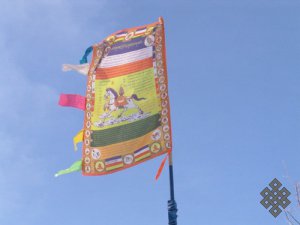 Relatives, friends and simply acquaintances invite each other for a visit. The doors are open to all. On they first day of this holiday women - housewives do not leave their home, because they are expected to meet the guests. Getting together separately, they can go visiting only from the second or third day. I noticed that during the New Year holidays, their Kazakh neighbors come visiting as well.
Relatives, friends and simply acquaintances invite each other for a visit. The doors are open to all. On they first day of this holiday women - housewives do not leave their home, because they are expected to meet the guests. Getting together separately, they can go visiting only from the second or third day. I noticed that during the New Year holidays, their Kazakh neighbors come visiting as well.
Traditional sports competitions in archery - mandatory part of the celebrations - were held on the second day of the holiday in Ak-Khaba village. It took two days from morning to dusk. Only men participate, it is believed that boys cannot pick up the heavy bow.
The 15th day in lunar calendar is considered to be the last day of Shagaa. A special holiday, named Meter, dedicated to the coming of Maitreya Buddha of the coming millennium is observed on this day. There are evening parties during which speeches of praise and khadaks are presented to respected older people or even to young ones who are good workers. Tuvans, as a rule, wear their national clothing for this holiday. In the town Burchin, for example, they set up a showing of child models of Tuvan folk costumes (on photos). Beside that, I was fortunate to witness a contemporary Tuvan wedding ritual, which preserved many archaic elements which we have already lost.
Lately, our relatives in China have been concerned about the questions of their future as an ethnos; will they be able to remain Tuvans in 50-60 years; will the next generations be able to keep the language, customs and traditions of their ancestors. These concerns have been born from the continual increase of Chinese 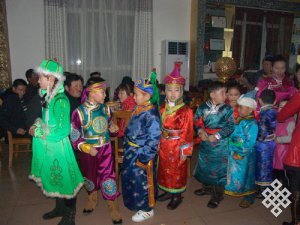 population in these areas.
population in these areas.
During my trips I was touched by the friendliness and kindness of the Tuvans. Each of them always reminded me: we are Tuvans, one nation, one blood.
As a result of these expeditions, much folkloric, ethnographic, historical, and linguistic material has been collected.
For me it is more than scientific material it is a spiritual treasure, which Tuvans, who live in China with billions of people of other ethnic background, were able to preserve despite their difficult historical fate. I bow to them. And from my whole heart I want to thank all of those whom I met, and personally Batyochur, Bubayak, Solongo, Kendzhe, Arshyna, Sesin, Kerel, and Ulana, for their hospitality, help and heartfelt conversations..

